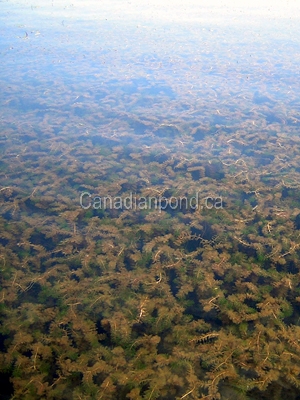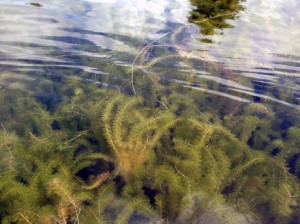Control of Water Milfoil
We already covered, in this article, various ways you can tackle invasive aquatic plant species in your pond or lakefront. However, water milfoil – also called zombie plant – deserves special attention because of its particularly aggressive nature.
Water milfoil can be controlled by combining benthic barriers, bottom aeration & beneficial bacteria.
Step 1: Use a benthic barrier to quickly eliminate the plant
If you have time and energy, a very useful step would be to apply a benthic barrier over the plants in the spring for about 4 weeks. Benthic barriers are also known as synthetic membrane, fiberglass membrane or jute barrier. We offer two versions of this product: the Lake Bottom Blanket or the Aquascreen. This cover will cut the light, killing the plant completely and leaving a whole area free of milfoil. Afterwards, the benefits of aeration will allow this state to persist. The tarp can then be moved to treat another area.
Remember: if you manually dig up the plants, do not dispose to your compost bin or compost site. This is an invasive plant that has to be sent to landfield.
Step 2: Aeration & Circulation
Generally, our bottom aeration systems consist of three components, placed one after the other:
- A compressor, powered by electricity or solar energy;
- Weighted tubing carrying compressed air to the aeration devices;
- An aeration device; either round individual diffusers, or linear Bubble Tubing® diffuser.
 These aeration systems will emit thousands of tiny air bubbles which rise to the surface pulling a column of water up with them. While adding much needed oxygen, this system will create a continuous turnover of water. Quantity of water that is circulated is in direct relation with the depth and the type of diffuser used. The result is well oxygenated water circulating through a Milfoil bed.
These aeration systems will emit thousands of tiny air bubbles which rise to the surface pulling a column of water up with them. While adding much needed oxygen, this system will create a continuous turnover of water. Quantity of water that is circulated is in direct relation with the depth and the type of diffuser used. The result is well oxygenated water circulating through a Milfoil bed.
Sometimes, we can use aerating fountains to create extra water movement and circulation. And in some other cases, Kasco circulators may be used to better control sediment accumulations.
A system must be designed to the specific needs of each location allowing for individual conditions such as:
- Density of Milfoil growth
- Size of area to be cleared
- Lake bottom condition – bottoms of Milfoil beds are usually made up of decaying organic matter – silt and muck.
- Water depth
Let’s take a typical system as an example. Let’s say we have a cottage with an extensive water milfoil bed at the water’s edge – the bed is 60 feet wide on the bank and extends up to 60 feet long in the water – a total of 3600 square feet to be treated. Milfoil growth is dense, the bottom is extremely muddy and the average depth is 10 feet. This situation would require two 50′ lines of Bubble Tubing®, each circulating water for 15 feet on either side. This produces a much less attractive environment for milfoil, which appreciates stagnant water. The cost of the system would be close to 3000$, if you install it yourself (the installation is very simple but, if in doubt, can be done by us). You will also need to budget for the addition of beneficial bacteria. Keep in mind that 3600 square feet is a fairly large surface area, probably larger than what most cottagers would have to clear.
Step 3: Bacteria
Once the environment is aerated and circulated, beneficial bacteria should be added to the mixture. The decomposition process of the organic matter at the bottom is accelerated by our specialized bacteria, which use oxygen to reduce the thickness of the sediment. The sediment releases nutrients back into the water, providing a prime substrate for the establishment of milfoil. Use Bacterius® MUCK for your lakefront, or Bacterius® 5B for your pond.
How does it work?
Milfoil requires an abundant supply of nutrients or it dies. Fundamentally the system operates by starving the Milfoil of nutrients. It does this in several ways:
- Circulating water attracts and holds some of the lake nutrients, thus depriving the Milfoil of some of its food availability.
- Well oxygenated water acts to oxidize the bottom muck so there is not the usual release of nutrients. Bacteria catalyzes these reactions.
- As the Milfoil thins out, other water plants, which were previously crowded out by the aggressive growth of the Milfoil, start to reappear and improve biodiversity.

The annual Milfoil growth cycle starts in the spring / early summer as the water starts to warm up. Growth as most of us well know is rapid and extensive through the summer and early fall. Eventually stems and surface mats die, reallocating their energy as reserves in the roots, to survive the winter and provide new growth in the spring. Circulation and aeration extend the fall life of the tops and leave the roots with less reserves to survive the freeze up period.
A word of warning – the Milfoil eradication program described above is not instantaneous. It can be very substantial very quickly, or it may take longer than one season to do the job. We do, however, have growing testimonials of its ultimate success.
Despite its possible slowness, there are definite advantages that compensate for the deployment of the aeration-circulation-bacteria approach. To name a few:
If we consider the concrete benefits – being able to swim in front of the cottage, getting the boat out without having to clean the propeller, etc. – the cost of purchasing and operating the system is probably worth it.
Control efforts will remain easy, almost non-existent. Once you have cleared your area, the system will be able to maintain this clear condition even if the milfoil remains in your bay or in the vicinity.
System maintenance is easy; simply plug in the compressor in the spring and unplug in November. Caution! You cannot operate the system once the ice starts to form, because you will have a very dangerous ice-free area for surface traffic such as ATVs, snowmobiles, etc..
The process is lake friendly. It helps moving from a eutrophic state, rich in nutrients supporting abundant plant growth including Milfoil and algae, to an oligotrophic state, scarce in nutrients and plant growth. These are the conditions normally found in a lake with a steep rocky shoreline and clear deep water.
If you have questions about these methods, or about alternate approaches to eradication, or wish to talk about a system for your cottage and get a specific quote, don’t hesitate to contact us.
Related content:
- La semaine verte | Myriophylle: L’envahisseur marin | ICI TOU.TV (Video; in French)
- Maine Citizen’s Guide to Invasive Aquatic Plant Management (PDF) by MVLMP (Maine Volunteer Lake Monitoring Program)